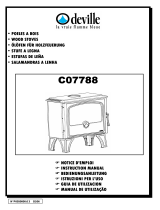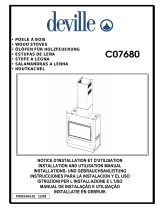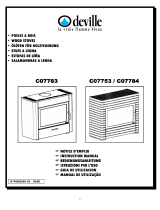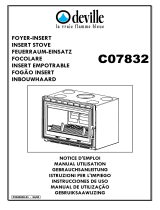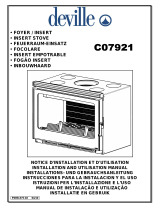Page is loading ...
Page is loading ...
Page is loading ...
Page is loading ...
Page is loading ...
Page is loading ...
Page is loading ...
Page is loading ...
Page is loading ...
Page is loading ...
Page is loading ...

12
CONTENTS
Page
1 - DESIGNATION ................................................................................................................ 13
2 - NOMINAL CALORIFIC POWER AND SLOW BURNING AUTONOMY .......................... 13
3 - DESCRIPTION AND SIZE................................................................................................ 14
3.1 DESCRIPTION
3.2 SIZE
3.3 VENTILATION OF THE AREA IN WHICH THE APPLIANCE IS TO BE INSTALLED
4 - STOVE OPERATING CONDITIONS................................................................................ 14
4.1 FIRST LIGHTING
4.2 FUEL
4.2.1 Fuel recommended
4.2.2 Forbidden fuel
4.3 USING THE HANDLING DEVICES AND THE ACCESSORIES
4.4 USE
4.4.1 Lighting
4.4.2 Operation
4.4.2.1 Periodic and continuous use
4.4.2.2 Fire duct
4.4.2.3 De-ashing
4.4.3 Safety instructions
5 - RECOMMENDATIONS RELATED WITH DUCT CLEANING, STOVE AND
SMOKE DUCT MAINTENANCE ........................................................................................... 17
6 - GLOBAL TERMS OF WARRANTY.................................................................................. 19

13
We strongly recommend reading carefully the entire manual in order to ensure the best possible use and the
highest satisfaction from your Deville stove.
Any non compliance with the assembly, installation and operating instructions is the sole responsibility of the
person performing any operation on the stove.
THIS STOVE MUST BE INSTALLED IN COMPLIANCE WITH THE CURRENTLY ENFORCED D.T.U.
SPECIFICATIONS.
All local, national, and European regulations must be respected when using this appliance.
The appliance must not be modified.
WE RECOMMENDED ASKING A QUALIFIED PROFESSIONAL TO INSTALL THE STOVE.
1 - DESIGNATION
These C07750 – C07787 – C07790 – C07708 – C07709 – C077AA stoves are complies with French standard
NF EN 13240.
These are constant heating system with grating combustion designed exclusively for wood burning, inside a
semi-closed combustion chamber.
2 - NOMINAL CALORIFIC POWER AND SLOW BURNING AUTONOMY
- Nominal calorific power according to standard NF EN 13240 during normal burning test: 9 kW.
The appliance can either be used in intermittent mode or in continuous mode.
Rated heat output capacity in intermittent use :
• Obtained through a 12 Pa draught, with a 2-kg wood load of an only unsplit tough log.
• Reload every 45 min on an ash bed :
0,3 kg (that is approximately 3 cm thick) for C07787
0,35 kg (that is approximately 3 cm thick) for C07750, C07790, C07708, C07709 and
C077AA
with the air ventilation pull handle opened to its maximum.
• The announced power is the average power obtained with each 45 minute-load.
Rated heat output capacity in continuous use :
• Obtained with a draft of 12 Pa, and a wood load of 9 kg. Loads are comprised of 2 unsplit
hardwood logs.
• Reload every 3 hours on an ash bed :
0,3 kg (that is approximately 3 cm thick) for C07787
0,35 kg (that is approximately 3 cm thick) for C07750, C07790, C07708, C07709 and
C077AA
with the air ventilation pull handle opened to its maximum.
• The announced power is the average power obtained with each 3 hours load.
Slow combustion, burning period superior to 10h in continuous use :
• Obtained on a 6 Pa draft with a 9 kg-load composed of a non-split log of strong wood, preferably
with large diameters (superior to 16 cm).
• Load and lay on an ash bed of about :
0,3 kg (that is approximately 3 cm thick) for C07787
0,35 kg (that is approximately 3 cm thick) for C07750, C07790, C07708, C07709 and
C077AA
with the air ventilation pull handle shut.

14
3 - DESCRIPTION AND SIZE
3.1 DESCRIPTION (Fig. 1)
The main elements of the stove are shown below :
(1) Handle
(2) Loading door
(3) Protection shield
(4) Top
(5) Duct
(6) Panel ou decoration
(7) Air inlet damper
A secondary air inlet is integrated in the upper section of the door window to maintain it clean and
ensure improved wood combustion.
The air inlet damper, located in the lower part of the door, allows the burn rate to be adjusted.
Stove net weight : C07750 Stove approx. 95 kg
C07787 Stove approx. 87 kg
C07790 Stove approx. 91 kg
C07708 Stove approx. 87 kg
C07709 Stove approx. 101 kg
C077AA Stove approx. 78 kg
3.2 SIZE (Fig. 2)
Outer dimensions (mm)
Width Height Depth
C07750 830 765 333
C07787 800 832 404
C07790 / C077AA 698 751 354
C07708 738 1077 355
C07709 738 1327 355
3.3 - VENTILATION OF THE AREA IN WHICH THE APPLIANCE IS TO BE INSTALLED
• The appliance needs air in addition to the air required by the statutory air change rate. This is obligatory when the
dwelling includes mechanical ventilation.
• The air intake should give directly to the outside or should be located in an area ventilated to the outside ; it
should also be protected by a grille.
• The air outlet should be as near as possible to the stove. The user should be able to close it off when it comes
out directly into the room. While the appliance is being used, make sure that it is free of any obstructions.
• The air intake section should be at least equal to one-quarter of the section of the smoke flue with a minimum of :
- 50 cm
2
for use with the door closed only
• It may be necessary to stop the extractor of the mechanical ventilation so as to avoid smoke coming back into the
room when the door is opened.
4 - STOVE OPERATING CONDITIONS
4.1 FIRST LIGHTING
- Once the chimney is implemented and the stove set, observe the drying time of the materials used for
the construction (2 to 3 weeks).

15
- Do not connect the stove to a pipe linked to several appliances.
- After first lighting (see paragraph 4.4.1), make a moderate fire for the first hours by limiting the stove's
load (a 15cm diameter log) (air damper half-open).
. Progressive heating of all the elements in the chimney and normal stove expansion.
- During the first hours of use, the stove may produce a smell of paint : ventilate the room to limit its
effects.
- Preparation of the C07709 to increase the capacity of the chaffing dish (see Fig. 11) :
In the case of a back connecting ; it is possible to dismantle the pipe cache of the chaffing dish, in
order to increase its volume, proceed as defined below :
. Lift the A cover to remove it.
. Remove the 2 B back screws from the decoration of the C chaffing dish.
. Remove the decoration from the chaffing dish.
. Remove the D cache pipe.
. Reassemble the decoration to the chaffing dish.
. Reassemble the top.
4.2 FUEL
4.2.1 Fuel recommended
Hardwood logs with a maximum length of 56 cm : oak, hornbeam, beech, chestnut, etc...
Maximum loading height : 25 cm.
We recommended using very dry wood (maximum 20% humidity), i.e. 2 years dry storage
following cutting, in order to obtain higher yields and avoid sooting the smoke duct and the
windows.
Do not use resinous woods (pine, fir, spruce, etc.), which involve more frequent maintenance of
the stove and the flue.
4.2.2 Forbidden fuel
Any other combustible than wood is forbidden, in particular coal and its by-products.
Burning kindling, canes, slats, straw, cardboard, liquid fuels is dangerous and should be avoided.
The appliance should not be used as a waste incinerator.
4.3 USING THE HANDLING DEVICES AND THE ACCESSORIES
- Air inlet damper (Fig. 3) : move using the poker.
- Door handle : move using the poker (Fig. 5) or an oven glove.
- Scraper (Fig. 4) : for ash removal and appliance cleaning.
Don't take the risk of burning your hands, use the fire irons.
LIGHTING REGISTER (Fig. 3)
Lighting position is obtained by moving the damper directly with your hand : this position must only be
used when the stove is ”cold”. It cannot be maintained more than 30 minutes. You must keep a close
eye on the stove during the lighting stage. To reach this position, you must follow the following steps:

16
Operation N°1 :
- Push the Air inlet damper's operating knob to the end point corresponding to the locked
"Lighting Position".
Operation N°2 :
- Lift the unlocking index located to the right of the adjustment damper.
Operation N°3 :
- Hold the index in high position with the right hand and push the operating knob to the right with
the left hand : you are in "Lighting Position".
After lighting the appliance, to return to normal, intermediate or reduced burning position (see Fig. 3),
use the poker to push the air damper operating knob as it may be hot.
4.4 USE
4.4.1 Lighting
-
Open the air damper to lighting position (Fig. 3).
- Place crumpled paper on the grating and very dry kindling wood (twigs), then larger cross-
section cut wood (diameter 3 to 5 cm).
- Light the paper and close the door (leave it partly open to accelerate lighting up).
- Once the "kindling wood" load is burning, open the door, load the appliance with the
recommended fuel and use the regulation devices to obtain the burning required.
4.4.2 Operation
4.4.2.1 Periodic and continuous use
- The intermittent use of the appliance requires a reload every 45 minutes.
This type of use is particularly recommended as it environmentally friendly.
- The apparatus may also be used in continuous mode when periodic use is not possible or when
reduced burning is required. In this case, maximum heat output can be maintained for 3 hours and
with a slow combustion rate, and a low heat output, the burning period can extend to 10 hours with a
9 kg load.
4.4.2.2 Fire duct
- The burning required is obtained by using the control devices (see § 4.3) and selecting a load
matching your needs, i.e.:
. For maximum heating, load the appliance with 3 logs of approx. 10 cm diameter (air damper open)
(Fig. 3).
Use this position only temporarily, to heat the rooms following prolonged absence.
. For intermediate heating, use a smaller load : one or two logs (air damper half-open) (Fig. 3).
. For a long-lasting heat output with a slow combustion rate, use 1 or 2 non-split logs with a diameter
superior to 15 cm (air damper closed) (Fig. 3).
- To get a long-lasting combustion rate, reload on a merely burning bed of embers.
- For rapid restarting of the fire, add some kindling wood, load the logs, and only if necessary keep
the door partly open for several minutes, without leaving the appliance unattended. Thereafter, use
the controls as per the instructions (paragraph 4.3). This method gets the fire going quickly again,
especially if the wood is slightly damp.
- Change the burning rate (switching from a slow combustion rate to a normal rate for example)
before reloading, during the combustion stage of the embers, to enable the appliance and smoke
duct to change progressively from one burning rate to another.

17
- To prevent smoke from driving back and the ash from entering the room, at the time of loading,
opening the door requires a number of precautions:
. Open the door partly, waits for the open door suction to start, and open the door slowly.
- Using the stove in continuous mode and a slow combustion rate, especially in milder temperature
conditions (bad draught) and with wet timber, leads to an incomplete combustion and the formation
of tar and soot deposits :
o Alternate the slow burning periods with returns to normal burning.
o Burning small loads is recommended
- After the stove has been used in slow combustion mode, the front glass may darken because of a
slight soot deposit, this deposit will burn off (by pyrolysis) with the next hot fire (higher combustion
rate).
The fitting of a suction moderating flap in the connecting duct enables to control the burning, notably slow
burning, enabling long lasting heating (see installation manual).
4.4.2.3 De-ashing
The air used for burning the wood comes in under the grate when the damper is open. This air also
ensures the cooling of the grating. Therefore, it is vital, to ensure optimum performance and prevent
the degradation of the grating due to overheating, to prevent any obstruction by performing regularly
de-ashing operations and evacuating the ash :
- Use the scraper (1) to de-ash the grating (Fig. 4).
- The ash pan, located under the grille, can be easily removed using the poker (Fig. 5).
- The level of ash must never reach the stove's cast iron grating : de-ash every 2 to 3 days.
- Remove periodically any ash which spilled accidentally in the ash box compartment.
4.4.3 Safety instructions
- Never throw water on the fire to put it out.
- The front glass as well as other parts of the stove are very hot : beware the risk of burns.
- The stove produces a large quantity of heat by means of radiation through the window : do not place
any materials or objects which are sensitive to heat within 1.5m of the windowed zone.
- It is imperative to maintain the loading closed at all times.
- Do not place any easily flammable materials near the appliance.
- Empty the ash pan into a special metal or otherwise inflammable receptacle used only for this
purpose. Ashes that might appear cold can still be very hot, even if you think they have had enough
time to get cold.
- It is especially important not to store wood under the appliance.
- If there is a fire in the chimney, shut the air ventilation pull handle (Fig. 3).
5 - RECOMMANDATIONS RELATED WITH DUCT CLEANING, STOVE AND SMOKE DUCT
MAINTENANCE
The mechanical cleaning of the smoke duct is compulsory, and must be performed several times per year, at
least during the heating season. A certificate should be handed in by a qualified professional.

18
At the time of duct cleaning, the following operations must be carried out :
- Dismount the deflector (Fig. 6) and (Fig. 7) :
. Dismount the deflector (lift the deflector 1, move it forward 2, tilt the rear 3, lower it 4 and
remove it 5 through the right-hand side).
- Dismount the rear plate of the hearth, the two lateral hearth plates, the hearth grid and the duct pipe.
(Assembling the deflector : perform the disassembly operation in the reverse order).
- Check thoroughly the state of the appliance and particularly the elements ensuring sealing : locking joints and
devices, supporting parts (door, frame).
- Check the state of the smoke duct and connecting duct : all the connections must show proper mechanical
resistance and sealing.
- Clean the appliance using a brush and a vacuum cleaner.
In the event of an anomaly : have the appliance repaired or the installation performed by a qualified professional.
After a long off-period :
- Check that nothing obstructs any pipes before using the stove again.
CURRENT MAINTENANCE
- Clean the window using a damp cloth and ash. If required, use an adapted household cleaning product by
observing the instructions of the operation manuals. Wait for the appliance to be completely cooled before
proceeding with this operation.
- Clean regularly the ventilation guides (Fig. 8) :
. Using the tip of a metallic object , scratch the inner edges of the cast iron to remove the soot
which may have formed.
. Using a vacuum cleaner , remove the particles and dust trapped between the door and window
(Fig. 9).
These particles prevent the forming of the secondary air layer which protects the window from direct contact
with the smoke and completes the combustion of the wood (Fig. 9).
. These operations must be performed whenever the window is dirty and systematically following the total
extinction of the hearth.
For C07787 :
• Check the efficiency of the door latch and, if required, make the following adjustments (Fig. 10) :
- To harden door closure :
. Successively loosen screw and tighten screw .
. Turn both screws ¼ turn and repeat the operation as required.
NOTE : This operation increases pressure on the hearth door's sealing gasket.
- To soften door closure:
. Successively loosen screw and tighten screw .
. Turn both screws ¼ turn and repeat the operation as required.
NOTE
: This operation reduces pressure on the hearth door's sealing gasket.

19
6 - GLOBAL TERMS OF WARRANTY
1. TERMS AND CONDITIONS
Apart from the legal warranty, particularly for latent defects, Deville guarantees to deliver the furniture in case of
obvious defects or non-conformity to the ordered furniture.
Without prejudice to the provisions that are to be taken concerning the carrier, claims on delivery of furniture
concerning the obvious defects or the non conformity, must be issued by the Buyer in writing a registered letter
with confirmation of receipt to Deville company with in 5 days after noticing the defect. It is up to the Buyer to
prove the reality of the noticed defects and irregularities. The Buyer must let Deville every opportunity of noticing
any of those defects and irregularities in order to salve then.
The Buyer must also keep the non standard supplies at the disposal of Deville, according to the instructions of
the latter. All return of material, for any reasons, should be subject to a formal pre – agreement from Deville.
2. EXTEND
The warranty of Deville covers, except for any compensation or for damages, the free replacement or repairing of
supplier the part acknowledged as being defected (except for wear and tear parts ) by its services to the
exclusion of the fees for the workplace, for the removal and for the shipping.
On enamelled equipments, appliances, crackles are never considered as a manufacturing defect. They are due
to the difference of expansion of iron enamel or cast-iron enamel and don’t alter the adherence.
Paid replacement parts are warranted for a six-month period from the invoicing date, any additional warranty
agreed by a retailer from Deville doesn’t commit Deville. Whenever claiming under a warranty, the guarantee
with the stamp from the retailer Deville is strictly required. The above guarantee must be produced for any
demand to repair the appliance under warranty, or a detachable slip or coupon of any such guarantee must,
according to the own organisation of Deville, be returned to the latter within the required time. For lack of this, the
date on the invoice issued by Deville can’t be taken into account. The interventions under warranty can’t have the
effect of continuing the warranty.
3. WARRANTY PERIOD
The period of the agreed warranty ensured by Deville is for 2 years (5 years for the fireplace heating body) from
the date when the appliance was purchased by the user, subject to the fact the claims -forecast by the above
conditions- were done within the time allowed. The repairing, the replacement or the alteration of parts under the
warranty period can neither have the effect of continuing the period of the latter, not get to any compensation for
any fees, for late delivery, accidents or any such damages.
4. EXCLUSION
The warranty is unavailable for the following cases, without this list being exhaustive :
Fitting out, fitting out and assembling of appliances not due to Deville.
Consequently Deville can’t be considered as responsible for damages or supplies, or accidents to persons due to
local laws and regulations (for example the fact that there is no linking to the earth ground connection or a wrong
drought of a fitting out).
Fair wear and tear of the supplies or abnormal use of the supplies including the case of industrial or trading use
or a use of the supplies in different conditions from the ones it was built for. It is, for example, of non respect of
the conditions described in the directions issued by Deville : display to outside conditions damaging the appliance
; such as excessive dampness or abnormal change of the electrical tension. Malfunction, damage or accident
due to a shock, a drop, a carelessness, a failure of supervision or of service from the Buyer.
Any alteration, change or intervention made by a member of the staff or a company that is not approved by
Deville, or manufactured with replacement parts that are not genuine or not approved by the manufacturer.
5. SPECIAL TERMS OF WARRANTY
These terms add and define the above general terms of warranty and come first to the former, refer to the
enclosed leaf untitled : “special terms of sales Deville - warranty”.
Page is loading ...
Page is loading ...
Page is loading ...
Page is loading ...
Page is loading ...
Page is loading ...
Page is loading ...
Page is loading ...
Page is loading ...

29
INDICE
Pagina
1 - DESIGNAZIONE ............................................................................................................. 30
2 - POTENZA CALORIFICA NOMINALE E AUTONOMIA IN FUNZIONAMENTO
RIDOTTO............................................................................................................................... 30
3 - DESCRIZIONE E MISURE D’INGOMBRO...................................................................... 31
3.1 DESCRIZIONE
3.2 MISURE D’INGOMBRO
3.3 VENTILAZIONE DEL LOCALE NEL QUALE VIENE INSTALLATO L’IMPIANTO
4 - CONDIZIONI D’USO DI QUESTO APPARECCHIO ........................................................ 32
4.1 PRIMA ACCENSIONE
4.2 COMBUSTIBILE
4.2.1 Combustibile raccomandato
4.2.2 Combustibili vietati
4.3 USO DEGLI ORGANI DI MANOVRA E DEGLI ACCESSORI
4.4 UTILIZZO
4.4.1 Accensione
4.4.2 Funzionamento
4.4.2.1 Funzionamento intermittente e continuo
4.4.2.2 Condotto del fuoco
4.4.2.3 Eliminazione cenere
4.4.3 Norme di sicurezza
5 - CONSIGLI DI PULITURA E DI MANUTENZIONE DELL’APPARECCHIO
E DEL CONDOTTO FUMARIO ............................................................................................. 35
6 - CONDIZIONI GENERALI DI GARANZIA......................................................................... 37
Page is loading ...
Page is loading ...
Page is loading ...
Page is loading ...
Page is loading ...
Page is loading ...
Page is loading ...
Page is loading ...

38
CONTENIDO
Páginas
1 - DESIGNACION ............................................................................................................... 39
2 - POTENCIA CALORIFICA NOMINAL Y AUTONOMIA EN MARCHA O REDUCIDA....... 39
3 - DESCRIPTIVO Y VOLUMEN........................................................................................... 40
3.1 DESCRIPTIVO
3.2 VOLUMEN
3.3 VENTILACION DEL LOCAL DONDE SE INSTALA EL APARATO
4 - CONDICIONES DE UTILIZACION DEL APARATO ........................................................ 41
4.1 PRIMER ENCENDIDO
4.2 COMBUSTIBLE
4.2.1 Combustible recomendado
4.2.2 Combustibles prohibidos
4.3 EMPLEO DE LOS ORGANOS DE MANEJO Y DE LOS ACCESORIOS
4.4 UTILIZACION
4.4.1 Encendido
4.4.2 Funcionamiento
4.4.2.1 Funcionamiento intermitente y continuo
4.4.2.2 Mantenimiento del fuego
4.4.2.3 Evacuación de las cenizas
4.4.3 Normas de seguridad
5 - CONSEJOS PARA EL DESHOLLINAMIENTO Y EL MANTENIMIENTO
DEL APARATO Y DEL CONDUCTO DE HUMOS................................................................ 44
6 - CONDICIONES GENERALES DE LA GARANTIA.......................................................... 46
Page is loading ...
Page is loading ...
Page is loading ...
Page is loading ...
Page is loading ...
Page is loading ...
Page is loading ...
Page is loading ...
Page is loading ...
Page is loading ...
Page is loading ...
Page is loading ...
Page is loading ...
Page is loading ...
Page is loading ...
Page is loading ...
Page is loading ...
Page is loading ...
Page is loading ...
Page is loading ...
Page is loading ...
Page is loading ...
Page is loading ...
Page is loading ...
Page is loading ...
Page is loading ...
/
